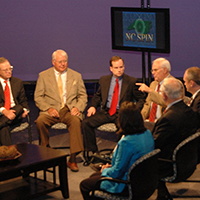House Bill 117, also known as the NC Competes Act, cleared the House by an 88-29 vote March 5. It was moved among three Senate committees before the Senate’s version was unveiled Aug. 5.
The Senate’s main carrot toward compromise was increasing annual financing for the Job Development Investment Grant (JDIG) program, one of Gov. Pat McCrory’s top agenda items for the last two legislative sessions.
However, the Senate version also includes sales tax revenue distribution. That had been removed from its state budget proposal as part of an attempt at compromise.
The Senate plan calls for the state to distribute half of sales tax revenues based on the point of sale and half based on population, effective next July. Currently, the majority of sales tax revenue stays in the county where the purchase is made.
Forsyth County is one of about 20 counties on the losing end of the proposed change. Forsyth and its municipalities would receive about 2 percent less in sales tax revenue next year compared to what they would receive if there were no change to the law, according to projections by the legislature’s fiscal research division.
Earlier Senate proposals called for the majority of revenue to be distributed based on population, which would have provided a boost to smaller counties but meant a big loss for some urban counties and tourist destinations.
Forsyth commissioners have sent a letter to legislators outlining their concerns about changing the distribution method and calling discussions about it “toxic, because it tends to pit areas of the state against each other.”
Sen. Joyce Krawiec, R-Forsyth, called the issue the most contentious the General Assembly has dealt with this session.
“My guess is that we are not going to get much better without a huge fight,” Krawiec said.
The Senate has agreed to provide an additional $5 million in JDIG financing — from $15 million to $20 million annually, and from $30 million to $35 million if there is a “high-yield project,” such as a major manufacturing plant.
By comparison, the House bill provides up to $45 million annually, and allots up to $20 million as an infrastructure enticement to help close major manufacturing projects, such as a long-coveted automobile plant.
To qualify as a high-yield project, companies would have to commit to creating at least 2,000 jobs and making a capital investment of at least $750 million. The JDIG program would be extended through Jan. 1, 2019.
Senate leaders said their version “adopts additional safeguards and reporting requirements to ensure that job recruitment dollars are administered responsibly and available throughout the entire year.”
A similar JDIG effort failed in 2014 after intense debate over providing additional incentives after legislators voted to reduce the corporate tax rate.
McCrory and Commerce officials have stressed that North Carolina is missing out on potential projects of all sizes, in part because of limited incentive monies, with some of it already committed to projects awarded in previous fiscal years.
Sen. Phil Berger. R-Rockingham, and the president pro tem, said he expects to reach a compromise on the bill, saying “Senate and House Republicans have always agreed that encouraging job growth and providing tax relief are top priorities — we just sometimes differ on the details.”
The Senate version makes a financial concession for the state’s rural counties when it comes to community matching of One North Carolina grant money.
Tier 1 counties, considered the state’s 40 least economically viable, would provide $3 for every $1 in local financing. Tier 2 counties, the next 40 counties on the economic viability rankings, would receive $2 in state money for every $1 in local financing. Tier 3 counties, such as Forsyth and Watauga, would continue to get a $1 for $1 state match.
The Senate version would implement the single-sales factor method for determining corporate income tax. According to The News & Observer of Raleigh, that method calculates companies’ tax liability based entirely on their sales instead of also factoring in their payroll and property value, resulting in an overall tax cut.







